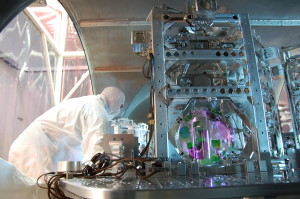
National Science Foundation funds a magnificent, historic discovery
The discovery demonstrates the ability of government to advance basic research by committing grants to responsible people.
Maybe you’ve heard. The nation has been debating the roles and policies of the federal government. To tell you the truth, I’ve mostly tuned out the repulsive noise from and about the candidates. But there is one activity in which the government engages that, this week, has brought an element of grandeur to national life.
This comes from the National Science Foundation. You don’t have to be an astrophysicist to appreciate the discovery of — and I won’t try to paraphrase this — “ripples in the fabric of spacetime called gravitational waves, arriving at Earth from a cataclysmic event in the distant universe.” Albert Einstein predicted these ripples back in 1915, but no one was able to confirm them until now. Basically what scientists have discovered is the nearly incalculable power of a collision between two black holes more than a billion light years from here. That is today, the event took place 1.3 billion years ago.
Ironically, Einstein, though he believed the waves to exist, didn’t buy into the source, black holes.

The discovery came from two facilities funded by the NSF. They’re called Laser Inferomoeter Gravitational-wave Observatory detectors, or LIGO. Not surprisingly LIGO detectors were thought up by brains at CalTech and MIT, who operate them.
Just imagine two black holes, each 50 times the mass of the sun, creeping toward each other then accelerating, colliding, and blending. Some of their mass gets converted to energy and, voila, E=MC². OK, I’m simplifying.
A lot of computational math and tweaking of the LIGO detectors went into this discovery. If you like statistics and can be amazed by both the gigantic and the minute, read more at the NSF website. Eventually, the LIGOs underwent a total overhaul for a step-function increase in their sensitivity. It’s not as if a gravity wave will suddenly make an apple lift off the ground back into the tree. Scientists are looking at tiny fluctuations in numbers.
The whole thing shows the ability of government to advance basic research by committing grants to responsible people. NSF lists a large number of universities and technologies worldwide as contributing to the discovery. It involved 1,000 people over nearly 25 years. A spokesman for the LIGO Scientific Collaboration said the discovery launches a new field called gravitational wave astronomy.
Two questions:
First, is this important? Of course it is. Whether it leads you to God Almighty or the conclusion that all existence is a random, mathematical construct, a discovery like this fulfills civilized peoples’ yearning to understand the universe. Whether something practical like Velcro or a reusable rocket will come out of it, who knows. But every piece of knowledge has value, and this is an enormous piece of knowledge.
Second, should the government fund it? I’ll answer with a question. Who else would pay for it with no chance of commercialization other than those who actually did, namely the federal government and the universities involved?
Copyright © 2025 Federal News Network. All rights reserved. This website is not intended for users located within the European Economic Area.
Tom Temin is host of the Federal Drive and has been providing insight on federal technology and management issues for more than 30 years.
Follow @tteminWFED





